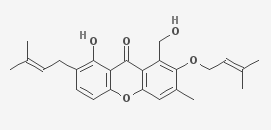Isoemericellin
Isoemericellin is a chemical compound belonging to the class of substances known as secondary metabolites, which are produced by various organisms, often serving as defense mechanisms or signaling molecules. Isoemericellin is specifically a mycotoxin, a type of secondary metabolite produced by fungi. This compound has been isolated from the fungus Emericella spp., which is a notable source of various chemically interesting and biologically active secondary metabolites.
Chemistry[edit | edit source]
Isoemericellin is characterized by its complex molecular structure, which includes multiple ring systems and functional groups that contribute to its biological activity. The exact chemical structure of isoemericellin includes a core framework typical of many fungal metabolites, with specific substituents that define its unique properties.
Biological Activity[edit | edit source]
The biological activities of isoemericellin have been the subject of research due to its potential pharmacological properties. Like many mycotoxins, isoemericellin exhibits a range of biological effects, including antimicrobial, antiviral, and cytotoxic activities. Its ability to inhibit the growth of certain bacteria and fungi makes it a compound of interest in the development of new antibiotics. Additionally, the cytotoxic properties of isoemericellin suggest potential applications in cancer research, where it could be used to target specific types of cancer cells.
Isolation and Synthesis[edit | edit source]
Isoemericellin is typically isolated from cultures of Emericella spp. fungi. The isolation process involves the extraction of the compound from fungal cultures, followed by purification techniques such as chromatography. Synthetic approaches to isoemericellin have also been explored, aiming to produce the compound in the laboratory without the need for fungal cultures. These synthetic methods involve complex chemical reactions that mimic the natural biosynthetic pathway of isoemericellin in fungi.
Applications[edit | edit source]
While the primary interest in isoemericellin lies in its potential pharmacological applications, the study of this compound also contributes to our understanding of fungal secondary metabolism. Research into the biosynthesis, regulation, and ecological roles of isoemericellin and related compounds can provide insights into the complex interactions between fungi and their environment, including their roles in microbial communities and their interactions with host organisms.
Safety and Toxicology[edit | edit source]
As with many mycotoxins, the safety and toxicological profile of isoemericellin is an important consideration. The potential health risks associated with exposure to isoemericellin, particularly in contaminated food or feed, necessitate careful study. Understanding the mechanisms of toxicity and the dose-response relationship of isoemericellin is crucial for assessing its risks and benefits, especially in the context of its potential use in medicine.
Search WikiMD
Ad.Tired of being Overweight? Try W8MD's physician weight loss program.
Semaglutide (Ozempic / Wegovy and Tirzepatide (Mounjaro / Zepbound) available.
Advertise on WikiMD
|
WikiMD's Wellness Encyclopedia |
| Let Food Be Thy Medicine Medicine Thy Food - Hippocrates |
Translate this page: - East Asian
中文,
日本,
한국어,
South Asian
हिन्दी,
தமிழ்,
తెలుగు,
Urdu,
ಕನ್ನಡ,
Southeast Asian
Indonesian,
Vietnamese,
Thai,
မြန်မာဘာသာ,
বাংলা
European
español,
Deutsch,
français,
Greek,
português do Brasil,
polski,
română,
русский,
Nederlands,
norsk,
svenska,
suomi,
Italian
Middle Eastern & African
عربى,
Turkish,
Persian,
Hebrew,
Afrikaans,
isiZulu,
Kiswahili,
Other
Bulgarian,
Hungarian,
Czech,
Swedish,
മലയാളം,
मराठी,
ਪੰਜਾਬੀ,
ગુજરાતી,
Portuguese,
Ukrainian
Medical Disclaimer: WikiMD is not a substitute for professional medical advice. The information on WikiMD is provided as an information resource only, may be incorrect, outdated or misleading, and is not to be used or relied on for any diagnostic or treatment purposes. Please consult your health care provider before making any healthcare decisions or for guidance about a specific medical condition. WikiMD expressly disclaims responsibility, and shall have no liability, for any damages, loss, injury, or liability whatsoever suffered as a result of your reliance on the information contained in this site. By visiting this site you agree to the foregoing terms and conditions, which may from time to time be changed or supplemented by WikiMD. If you do not agree to the foregoing terms and conditions, you should not enter or use this site. See full disclaimer.
Credits:Most images are courtesy of Wikimedia commons, and templates Wikipedia, licensed under CC BY SA or similar.
Contributors: Prab R. Tumpati, MD

